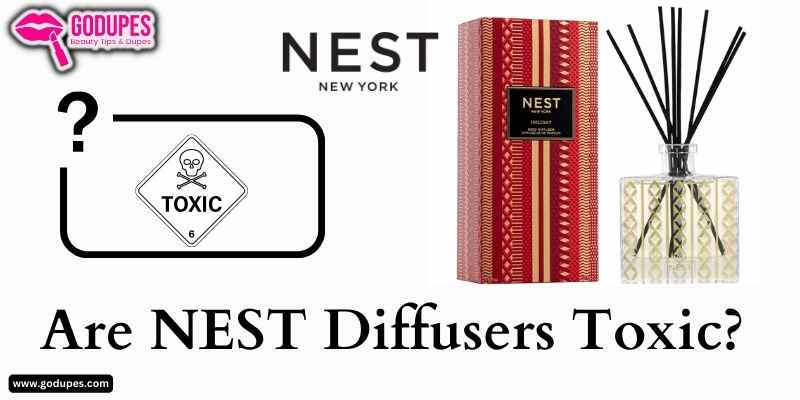NEST diffusers might contain some toxins, but some are designed to be safe. Check labels for harmful chemicals like VOCs. Opt for natural essential oil diffusers for a safer choice.
Nest Perfume & Toxicity
The main concern with NEST diffusers centers around the fragrance oils they use. Despite claims of using “high-quality essential oils and fragrance oils,” the exact composition of these fragrances is often undisclosed.
VOCs in Fragrances
A significant issue with synthetic fragrances in diffusers, including some NEST products, is the presence of volatile organic compounds (VOCs). The EPA highlights that indoor air pollution can be 2 to 5 times higher than outdoor levels, largely due to these compounds. A 2017 University of California, Berkeley study found that 95% of tested fragrances contained VOCs, some with up to 17 different types.
VOCs are linked to various health issues, from headaches and dizziness to respiratory problems. The World Health Organization has flagged long-term exposure to VOCs as a potential cause of cancer and other chronic conditions.
Health Risks of VOCs
Exposure to VOCs is associated with a range of health problems. According to the WHO, these include eye irritation, respiratory issues, and potential carcinogenic effects. A 2019 Journal of the American Medical Association study found a connection between long-term VOC exposure and an increased risk of chronic obstructive pulmonary disease (COPD).
Plasticizers in Reeds
In 2018, the Center for Environmental Health revealed that 96% of synthetic rattan reeds contained BPA and/or phthalates. These substances are known endocrine disruptors, potentially impacting fertility and overall health.
Hidden Ingredients and Their Risks
Beyond fragrance oils and reed sticks, diffusers may contain additives like preservatives, solvents, and dyes. Although less common in NEST products, these can cause irritation and allergic reactions, especially in sensitive individuals.
Preservatives and Solvents
While NEST products may use fewer harmful additives, some diffusers contain preservatives like formaldehyde and solvents such as limonene. These can irritate, particularly in sensitive individuals.
Fragrance Allergies
The American Academy of Allergy, Asthma & Immunology estimates that fragrance allergies affect 3% of adults and 1% of children. Reactions can range from skin irritations to severe respiratory issues.
We have already written our stance on Pura Scents, read here!
The Bigger Picture
The global fragrance market, expected to reach $37.7 billion by 2027, sees a rising trend in natural fragrances, growing at 5.4% annually. This shift is driven by growing consumer awareness and concerns over synthetic chemicals. The National Center for Health Statistics in 2022 reported that 1 in 5 Americans use essential oils, reflecting a heightened interest in natural wellness practices.
Steps for Safe Diffusion
To ensure a safe diffusing experience, consider the following tips:
- Choose Transparent Brands: Prefer brands that disclose their fragrance ingredients. Avoid products with vague descriptions like “fragrance blend.”
- Opt for Essential Oils: Choose diffusers with pure essential oils, which are generally safer than synthetic fragrances.
- Seek Certifications: Look for certifications like USDA Organic or Ecocert, indicating stricter ingredient standards.
- Place Diffusers Wisely: Keep diffusers away from children, pets, open flames, and heat sources.
- Ventilate Your Space: Ensure good air circulation, particularly in smaller rooms, to prevent high concentrations of fragrances.
- Listen to Your Body: Pay attention to any adverse reactions like headaches or respiratory issues, and stop using the diffuser if these occur.
- Use Timers: Control exposure by using diffusers intermittently rather than continuously.
- Embrace Natural Aromas: Explore natural scents like fresh herbs, lavender, and citrus fruits as alternatives to diffusers.
Alternative Aromatic Options
If you’re still concerned about using diffusers, consider these alternatives:
- Ultrasonic Diffusers use water vapor and ultrasonic vibrations to disperse essential oils, reducing VOC emissions.
- DIY Diffusers: Create your diffusers with essential oils and carrier oils like almond oil for a customizable, safe experience.
- Aromatherapy Candles: Choose candles made with natural soy wax and essential oils, but be aware of potential soot emissions.
- Potpourri: Use dried flowers and natural scents to fill your space with pleasant aromas.
Are Nest Diffusers Toxic to Dogs?
Nest diffusers, while not outright toxic, can pose risks to dogs. The oils used in these diffusers often lead to respiratory irritation in pets. It’s essential to keep these diffusers out of your dog’s reach and watch for signs of respiratory distress, such as coughing or difficulty breathing.
Is Nest Perfume Non-Toxic?
Nest perfumes, although not classified as toxic, contain synthetic fragrances and alcohol that may cause skin and eye irritation. It’s advisable to store these perfumes safely away from children and pets to prevent accidental contact or ingestion.
Are Reed Diffusers Safe in Bedrooms?
Using reed diffusers in bedrooms is generally safe if you exercise caution. Ensure the room is well-ventilated and limit the diffusion time. Keep the diffuser away from children and pets. For a safer option, choose diffusers with natural essential oils rather than synthetic fragrances.
Are Reed Diffusers Carcinogenic?
Certain reed diffusers contain synthetic fragrances that include VOCs, which are sometimes linked to cancer risks. To minimize this risk, select reed diffusers that use natural essential oils. Look for products with organic certifications like Ecocert or USDA Organic, indicating stricter control of ingredients.
Is NEST New York Diffusers Safe?
NEST New York diffusers have sparked safety concerns due to ingredients like synthetic fragrances and VOCs. These components may irritate some users but are not generally toxic. For a safer aromatic experience, consider alternatives such as ultrasonic diffusers using essential oils, or natural scents from herbs and flowers.

